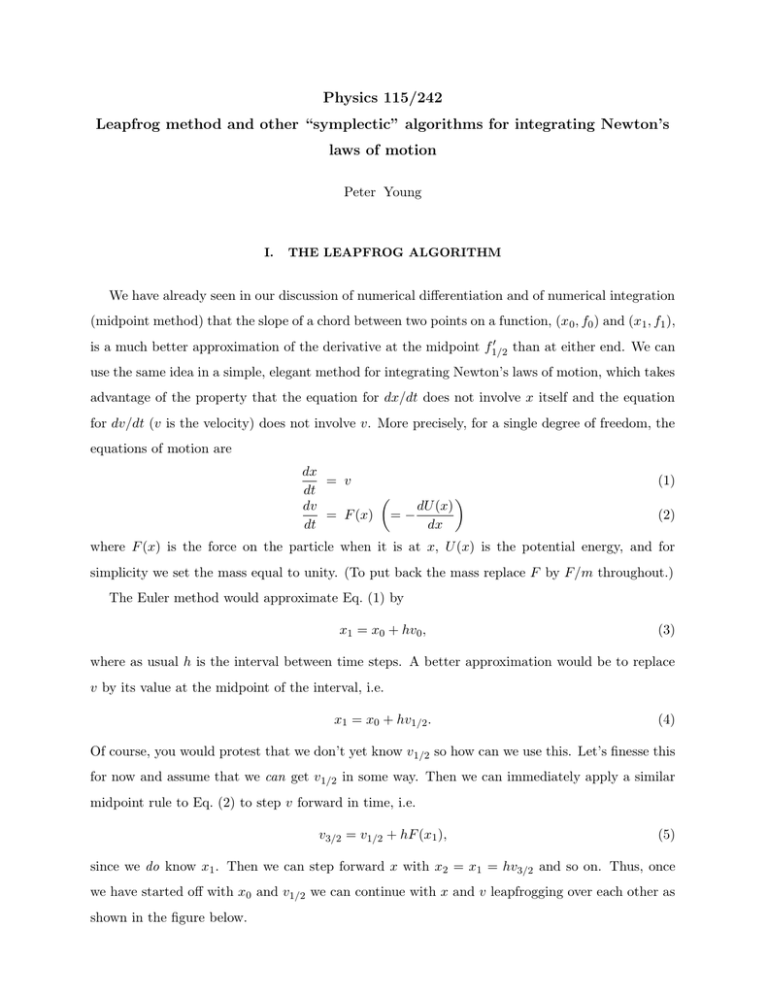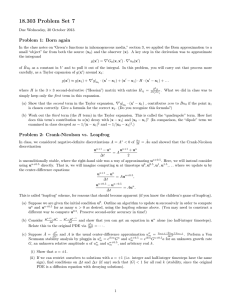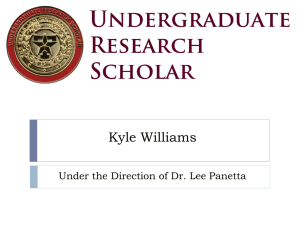Physics 115/242 Leapfrog method and other “symplectic” algorithms for integrating Newton’s
advertisement

Physics 115/242
Leapfrog method and other “symplectic” algorithms for integrating Newton’s
laws of motion
Peter Young
I.
THE LEAPFROG ALGORITHM
We have already seen in our discussion of numerical differentiation and of numerical integration
(midpoint method) that the slope of a chord between two points on a function, (x 0 , f0 ) and (x1 , f1 ),
0
is a much better approximation of the derivative at the midpoint f1/2
than at either end. We can
use the same idea in a simple, elegant method for integrating Newton’s laws of motion, which takes
advantage of the property that the equation for dx/dt does not involve x itself and the equation
for dv/dt (v is the velocity) does not involve v. More precisely, for a single degree of freedom, the
equations of motion are
dx
= v
dt
dv
dU (x)
= F (x) = −
dt
dx
(1)
(2)
where F (x) is the force on the particle when it is at x, U (x) is the potential energy, and for
simplicity we set the mass equal to unity. (To put back the mass replace F by F/m throughout.)
The Euler method would approximate Eq. (1) by
x1 = x0 + hv0 ,
(3)
where as usual h is the interval between time steps. A better approximation would be to replace
v by its value at the midpoint of the interval, i.e.
x1 = x0 + hv1/2 .
(4)
Of course, you would protest that we don’t yet know v1/2 so how can we use this. Let’s finesse this
for now and assume that we can get v1/2 in some way. Then we can immediately apply a similar
midpoint rule to Eq. (2) to step v forward in time, i.e.
v3/2 = v1/2 + hF (x1 ),
(5)
since we do know x1 . Then we can step forward x with x2 = x1 = hv3/2 and so on. Thus, once
we have started off with x0 and v1/2 we can continue with x and v leapfrogging over each other as
shown in the figure below.
2
x
t/h
0
1
2
3
4
5
6
7
v
The basic integration formula for the leapfrog algorithm is therefore
xn+1 = xn + hvn+1/2
vn+3/2 = vn+1/2 + hF (xn+1 ).
(6)
(7)
How accurate is this approach? Well x1 − x0 is of order h, and we showed earlier in the class
that the expected leading error ∼ h2 vanishes for the midpoint approximation, and so the error
for one interval is ∼ h3 . To integrate over a finite time the number of intervals ∝ 1/h and so the
overall error is of order h2 . Leapfrog is therefore a second order method, like RK2, and better
than Euler, which is only first order. We shall see shortly that, in addition to leapfrog being of
higher order than Euler even though it is hardly more complicated, it has other desirable features
connected with its global properties.
The leapfrog method has a long history. I don’t know who first introduced it but there is a nice
discussion in the Feynman Lectures on Physics, Vol. I, Sec. 9.6.
II.
THE VELOCITY VERLET ALGORITHM
To make leapfrog useful, however, two questions have to be addressed. The first, which we have
already mentioned, is how to we start since we need v1/2 , but we only have the initial velocity v0
(as well as the initial position x0 ). The simplest approximation is just to do a single half step
v1/2 = v0 + 12 hF (x0 ).
(8)
Although this is not a midpoint method, and so has an error of h2 we only do this once so it
does not lower the order of the method, which remains second order. The second question to be
addressed is how can we get the velocity at the same time as the position, which is needed, for
example, to produce “phase space” plots (see below) and to to compute the energy and angular
momentum. The simplest approach is just to consider Eq. (7) to be made up of two equal half
steps, which successively relate vn+1 to vn+1/2 and vn+3/2 to vn+1 . The leapfrog algorithm with
3
a means of starting the algorithm and determining x and v at the same times in the way just
mentioned, is called velocity Verlet. A single time step can be written as
vn+1/2 = vn + 12 hF (xn )
xn+1 = xn + hvn+1/2
(9)
vn+1 = vn+1/2 + 21 hF (xn+1 ).
If we are not interested in v at integer times, this is exactly the same as Eqs. (6) and (7), apart
from the initial computation of v1/2 . It looks as though we have to do two force calculations per
time step in Eq. (9) but this is not so because the force in the third line is the same as the force
in the first line of the next step, so it can be stored and reused. Since velocity Verlet is the same
as leapfrog, it is a second order method.
It is often useful to show the trajectory as a “phase space” plot i.e. the path in the p-x plane
(where p = mv is the momentum). As an example consider the simple harmonic oscillator for
which the energy is given by E = p2 /2m + kx2 /2, where k is the spring constant. Here we have
set m = 1 and we will also set k = 1 so
E=
p2 x 2
+
2
2
(= const.)
Hence the phase space plot is a circle with radius equal to
√
(10)
2E.
The above figure shows a phase space plot for one period of a simple harmonic oscillator using
the velocity Verlet method with time step h = 0.02T , where T = 2π is the period. The starting
4
values are x = 1, v = 0, so E = 1/2. The figure shows that the leapfrog/velocity Verlet method
correctly follows the circular path in phase space (at least for one period T ).
Note that instead of starting with a half step for v followed by full step for x and another half
step for v, one could do the opposite: a half step for x followed by full step for v and another half
step for x, i.e.
xn+1/2 = xn + 12 hvn
vn+1 = vn + hF (xn+1/2 )
(11)
xn+1 = xn+1/2 + 21 hvn+1 .
This is called position Verlet. Once the algorithm has been started it is the same as velocity Verlet.
It is trivial to generalize the equations of the leapfrog/Verlet method to the case of more than
one position and velocity. For example, for the position Verlet algorithm one has
xin+1/2 = xin + 12 hvni
(i = 1, · · · , N )
i
vn+1
= vni + hF i ({xn+1/2 })
(i = 1, · · · , N )
i
xin+1 = xin+1/2 + 12 hvn+1
(i = 1, · · · , N ),
(12)
where xi , v i (i = 1, 2, · · · , N ) are the positions and velocities, and F i ({x}) is the force which gives
the acceleration of the coordinate xi , i.e. F i ({x}) = −∂U ({x})/∂xi , where U is the potential
energy. Each force depends, of course, on the set of all positions {x}. It is important that all the
positions are updated in the first line of Eq. (12), then all the forces are calculated using the new
positions, then all the velocities are updated in the second line, and finally, all the positions are
updated again in the last line.
III.
THE VERLET ALGORITHM
If we are not interested in the velocities, but just the trajectory of the particle, we can eliminate
the velocities from the algorithm since
xn+2 = xn+1 + hvn+3/2
= xn+1 + h(vn+1/2 + hF (xn+1 )).
(13)
(14)
Now hvn+1/2 can be written as xn+1 − xn and so we get an equation entirely for the xn :
xn+2 = 2xn+1 − xn + h2 F (xn+1 ).
(15)
5
This Verlet algorithm is less often used than velocity or position Verlet because: (i) having the
velocities is frequently useful, (ii) the Verlet algorithm is not self starting, and (iii) it is more
susceptible to roundoff errors because it involves adding a very small term of order h 2 to terms of
order unity. By contrast, the velocity or position Verlet schemes only add terms of order h (which
is larger than h2 since h is small) to terms of order unity.
IV.
ADVANTAGES OF THE LEAPFROG/(VELOCITY OR POSITION) VERLET
ALGORITHM
In addition to combining great simplicity with second order accuracy, the leapfrog/(velocity or
position) Verlet algorithm has several other desirable features:
1. It is time reversal invariant.
Newton’s equations of motion are invariant under time reversal. What this means is as
follows. Suppose we follow a trajectory from xi at some initial time ti (when the particle
has velocity vi ) to xf at a later time tf (when the velocity is vf ). Now consider the time
reversed trajectory which starts, at time ti , at position xf but with the opposite velocity
−vf . Then, at time tf , the particle will have reached the initial position xi and the velocity
will be −vi , see the figure.
original trajectory
xf ,vf
xi ,vi
xi , −vi
time reversed trajectory
xf , − vf
This time reversed trajectory is what you would see if you took a movie of the original
trajectory and ran it backwards. Thus both the trajectory forward in time and the one
backwards in time are possible trajectories. Since this is an exact symmetry of the equations,
it is desirable that a numerical approximation respect it.
It is a matter of simple algebra to check that Eqs. (9) or (11) respect time reversal. Start
with x0 = X, v0 = V , say, and determine x1 and v1 . Then start the time reversed trajectory
with xr0 = x1 and v0r = −v1 . The three steps of Eqs. (9) or (11) in the reversed trajectory
6
correspond precisely to the three steps in the forward trajectory (with positions the same
and velocities reversed) but in the reverse order.
2. In a spherically symmetric potential, angular momentum is conserved and, remarkably, the
leapfrog/(velocity or position) Verlet algorithm conserves it exactly. If the potential energy
U only depends on the magnitude of ~r and not its direction then the force is along the
direction of ~r, i.e.
dU (r)
,
F~ (r) = −r̂
dr
(16)
where r̂ is a unit vector in the direction of ~r. It is left as a homework exercise to show that
the leapfrog algorithm conserves angular momentum for such a force. (Unfortunately energy
is not exactly conserved in the algorithm.)
It is obviously desirable that a numerical approximation respect symmetries exactly, and
I’m not aware of any other algorithms which conserve angular momentum, though they may
exist. This is obviously a “plus” for the leapfrog algorithm.
3. The leapfrog/(velocity or position) Verlet algorithm is “symplectic”, i.e. area preserving.
I will now explain this important concept. Consider a small rectangular region of phase
space of area dA as shown in the left part of the figure below.
p’
p
2
3
dp
dA 1
2
1 dx 4
dA’
3
4
time t’
time t
x
x’
Let the four corners of the square, (x, p), (x + dx, p), (x, p + dp), (x + dx, p + dp) represent
four possible coordinates of a particle at time t. These are labeled 1, 2, 3, 4. Then, at a later
time t0 each of these four points will have changed, to form the corners of a parallelogram,
as shown on the right of the figure. Let the area of the parallelogram be dA 0 . An important
theorem (Liouville’s theorem) states that the areas are equal, i.e.
dA0 = dA.
(17)
7
I have not been able to find a simple derivation of Liouville’s theorem. For a more advanced
text which gives a proof, see Landau and Lifshitz, Classical Mechanics. Now (x, p) transforms
to (x0 , p0 ), where x0 and p0 are some (complicated non-linear) functions of x, and p, i.e.
x0 = X(x, p)
p0 = P (x, p).
(18)
A set of equations like (18), in which the values of one set of variables (x, p here), is transformed to new values (x0 , p0 here), is called a map. Thus, the result of integration of Newton’s
laws by a finite amount of time can be represented as an area preserving map.
Since the area preserving property is an exact feature of the equations, it is desirable that a
numerical approximation preserve it. Such approximations are called symplectic.
What is the condition for a map to be symplectic? To see this we need to compute the area
dA0 in the above figure, and set it equal to dA = dx dp. The area dA0 is given by
dA0 = |d~e10 × d~e20 |,
(19)
where d~e10 and d~e20 are the vectors describing the two sides of the parallelogram, 1 → 4 and
1 → 2. Now the components of d~e10 are just the changes in x0 and p0 when x is changed by
dx but p is fixed, i.e.
d~e10
dx,
(20)
dp.
(21)
=
∂x0
∂p0
x̂ +
p̂
∂x
∂x
=
∂x0
∂p0
x̂ +
p̂
∂p
∂p
and similarly
d~e20
It is well known that the vector product in Eq. (19) can be represented as a determinant,
and so we get
dA0 = JdA,
(22)
where
∂x0
∂x
J = ∂x0
∂p
=
∂p0 ∂p
∂p0
∂x
∂x0 ∂x0 ∂x ∂p 0
0
∂p ∂p ∂x ∂p (23)
8
is the Jacobian of the transformation from (x0 , p0 ) to (x, p) which occurs when you change
variables in an integral, i.e.
ZZ
0
0
. . . dx dp =
ZZ
. . . J dxdp.
(24)
In Eq. (23) we have noted the a determinant of the transpose of a matrix is the same as that
of the original matrix.
To show that the leapfrog algorithm is symplectic it is convenient to consider each of the
three steps in Eq. (9) separately (remember we have m = 1 here so p and v can be used
interchangeably):
δx1
δx1
,
=C
δv1/2
δv1
δx1
δv1/2
δx0
δx0
1
δx0
= A ,
δv0
δv1/2
,
=B
δv1/2
(25)
where
C=
1
0
h F 0 (x ) 1
1
2
,
B=
1 h
0 1
,
A=
0
h F 0 (x ) 1
0
2
,
(26)
so
δx1
δv1
=J
δx0
δv0
,
(27)
where J is given by the matrix product
J = CAB .
(28)
It is an important (but not sufficiently well known) theorem that the determinant of a
product of matrices is the the product of the determinants, i.e.
det J = det C det B det A .
(29)
By inspection, det A = det B = det C = 1, and so det J = 1, i.e. the leapfrog/velocity Verlet
algorithm is symplectic.
However, J is not equal to unity for the other algorithms that we have considered, Euler,
RK2 and RK4. (Since RK4 is very accurate the change in area will be small, of order h 4 ,
but not zero.)
The advantage of symplectic algorithms is that they possess a sort of global stability. Since
the area bounded by adjacent trajectories is preserved, we can never have the situation
9
that we clearly saw for the Euler algorithm, where the coordinates (and hence the energy)
increase without bound, because this would expand the area. Even in better non-symplectic
approximations, such as RK2 and RK4, the energy will eventually deviate substantially from
its initial value.
In fact one can show that the results from an approximate symplectic integrator are equal
to the exact dynamics of a “close by” Hamiltonian, H 0 (h) where, for the case of a second
order method like leapfrog,
H0 (h) = H + (. . .) h2 + (. . .) h3 + · · · ,
(30)
in which
H=
p2
+ V (x)
2m
(31)
is the actual Hamiltonian and (. . .) represent the extra pieces of H 0 (h).
V.
NUMERICAL RESULTS
We now show some numerical data which illustrates the symplectic behavior of the leapfrog
algorithm. As usual, we take the simple harmonic oscillator, with time step h = 0.02T
(where T is the period).
10
The above figure shows that although the energy deviates from the exact value, it never
wanders far from the exact result. By contrast, in the RK2 algorithm the energy deviates
more and more from the exact value as t increases, as shown by the thick dashed line in the
figure. The energy in the leapfrog method oscillates around the correct value because the
method is symplectic. Note that for small times (less than a quarter period), the error with
leapfrog is actually rather worse than with RK2 (though both are of order h 2 ). It is in the
long time behavior that leapfrog is better since it has “global stability”.
VI.
HIGHER ORDER SYMPLECTIC ALGORITHMS
Recently there has been interest in higher order algorithms which respect time reversal
invariance and which are symplectic. The simplest higher order symplectic algorithm is
that of E. Forest and R.D. Ruth, Physica D, 43, 105 (1990), and extensions discussed in
e.g. Omelyan, Mryglod and Folk, http://arxiv.org/abs/cond-mat/0110585, which are of
fourth order. If initially x = x(t), v = v(t) then, in the Forest-Ruth algorithm, the following
steps
h
x = x+θ v
2
v = v + θhF (x)
h
x = x + (1 − θ) v
2
v = v + (1 − 2θ)hF (x)
h
x = x + (1 − θ) v
2
v = v + θhF (x)
h
x = x + θ v,
2
(32)
1
√ ' 1.35120719195966,
2− 32
(33)
with
θ=
yield x(t + h), v(t + h) and so generate one time step. Note that this method requires three
evaluations of the force per time step, as opposed to just one for leapfrog. Note too that
the steps are symmetric about the middle one (this ensures time reversal invariance). Since
each step involves simply moving forward either the position or the velocity, the Jacobian
of the transformation can be written, as for the leapfrog method discussed above, as a the
11
product of determinants (7 here) each of which trivially has determinant unity. Hence the
algorithm is symplectic. The hard work is to show that the algorithm gives an error of order
h5 for one interval (and hence of order h4 when integrated over n = ∆t/h time steps for a
fixed time increment ∆t). This is where the strange value for θ comes from.
It is curious that the middle step of the Forest-Ruth algorithm is larger in magnitude than
h (and it, and some of the other steps, go “backwards in time”). This large step turns
out out to be necessary to get a 4-th order symplectic algorithm requiring only three force
evaluations per time step. If one is willing to accept more than 3 force evaluations one can
avoid having a step greater in magnitude than h, e.g. the “PEFRL” algorithm of Omelyan
et al. in Eq. (34) below. However, to my knowledge, all higher order symplectic algorithms
have some steps which go backwards in time.
One time step in the “Position Extended Forest-Ruth Like” (PEFRL) algorithm of Omelyan
et al. is
x = x + ξhv
h
v = v + (1 − 2λ) F (x)
2
x = x + ξhv
v = v + λhF (x)
x = x + (1 − 2(χ + ξ))hv
(34)
v = v + λhF (x)
x = x + ξhv
h
v = v + (1 − 2λ) F (x)
2
x = x + ξhv
with
ξ = +0.1786178958448091E+00
λ = −0.2123418310626054E+00
(35)
χ = −0.6626458266981849E−01
This algorithm requires 4 force evaluations per time step rather than 3 for Forrest-Ruth, but
it is more accurate, as we will see below, since it avoids the large time step.
The following table shows results for the maximum error in 2E over one period (2E = 1 for
12
the specified initial conditions x = 1, v = 0) for the leapfrog algorithm, Forest-Ruth (FR)
algorithm, and the PEFRL algorithm of Omelyan et al.
h/T
leapfrog
FR
PEFRL
0.02 3.949 × 10−3 1.912 × 10−5 7.206 × 10−7
0.005 2.468 × 10−4 7.416 × 10−8 2.822 × 10−9
By comparing the errors for the two different values of h/T one can see that the error in the
leapfrog algorithm varies as h2 while that in the FR and PEFRL algorithms varies as h4 .
Furthermore the PEFRL algorithm is about 26 times more accurate than the FR algorithm
for the same value of h.
To make a fair comparison of the efficiency of the leapfrog and PEFRL algorithms, one
should note that the PEFRL algorithm requires 4 times as many function evaluations per
step. Hence we compare PEFRL with h/T = 0.02 and leapfrog with h/T = 0.005, which
require the same number of steps; the result is that PEFRL is about still about 340 times
more accurate.
One frequently obtains detailed dynamical information about interacting classical systems
from “molecular dynamics” (MD) simulations, which require integrating Newton’s equations
of motion over a long period of time starting from some initial conditions. Since global
stability is important for integration over long times, fourth-order symplectic algorithms are
likely to play a major role in MD simulations in the future, since these algorithms combine
relative simplicity with accuracy and global stability. However I agree with Omelyan et
al. that symplectic integrators of order greater than 4 are probably not worth the extra
complexity.






